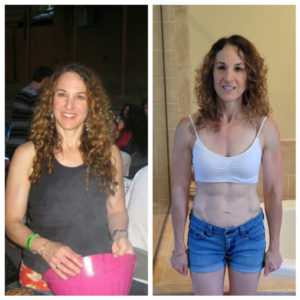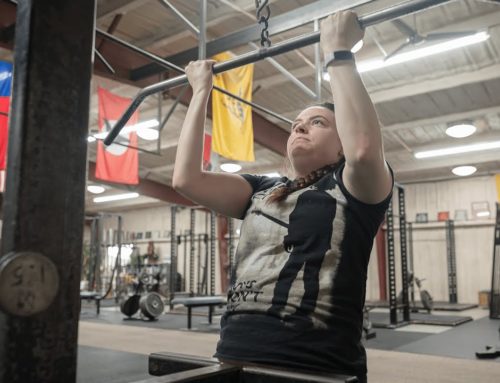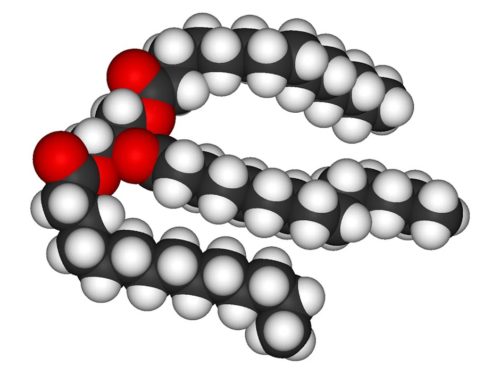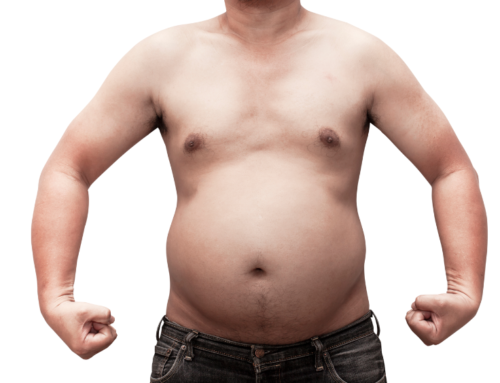by Robert Santana, MS, RD, SSC
“The vast majority of women cannot get large, masculine muscles from barbell training. If it were that easy, I would have them.” – Mark Rippetoe

As we know, there is an abundance of misinformation about fitness, weight training, nutrition, and injury rehab and prevention. The healthcare and fitness industries have led the general public astray when it comes to movement science, health, diet, and body composition. One segment of the population that receives more than their fair share of misinformation is actually half the population: females. This is especially true here in Los Angeles, where plastic surgeons and “weight loss gurus” are the modern day Joe Camels on our billboards.
Women have historically been told that lifting heavy weights will make them big, bulky, and less ladylike for reasons I still do not quite understand. Maybe the individuals sending these messages are simply intimidated by a strong woman. Or maybe they just simply don’t know what they are talking about. We may never know. I can’t speak for anyone else but most of my clients are women and I suspect this to be true in many gym or fitness settings.
Many modern-day lifters, both men and women, have some sort of aesthetic goal, and whether we like it or not we must account for this in our programming. Things tend to get fuzzy when separating the role of diet and the role of training with regards to changes in body composition. Training the way we train increases strength and muscle mass. If fat loss is a goal, then this must be addressed nutritionally. Every time I meet a new trainee, I tell them that there is no such thing as a fat-loss training program, only a fat-loss nutrition program. Lifting is not for everybody and fat loss can certainly occur while participating in other physical activities, so long as those activities are accompanied by a dietary intervention.
The purpose of this article is to dispel some of the misinformation by sharing a female novice lifter’s experience on a linear progression. This article is not reflective of what typically happens to male lifters on a linear progression, so I apologize to the bodybuilders out there who are looking for an excuse to chase low bodyfat levels doing the training portion of the program. This is not for you.Once upon a time I started training a co-worker and fellow Registered Dietitian (RD). In the span of 4-6 months, with a short break in between to deal with a minor injury, this woman managed to deadlift 200% of her bodyweight, squat 142% of her bodyweight, bench press 103% of her bodyweight, press 78% of her bodyweight, and chin with an additional 22.5 pounds of weight hanging from her waist. All of this was achieved while dropping 9 pounds of bodyweight and reducing her bodyfat percentage to 15%. No bullshit – this woman got smaller and stronger lifting heavy weights and following an individualized nutrition program.
While 9 pounds may not sound like a whole lot of fat loss, anyone who has experience with losing bodyfat knows that losing it at a “normal” or “healthy” bodyfat percentage is far slower and requires stricter compliance than losing it at a high bodyfat percentage. Those complaining about being “skinny fat” know exactly what I am talking about. This lifter’s fat loss happened slowly and gradually, to the point where fractions of a pound were lost on a weekly, and sometimes bi-weekly, basis while continuing to add weight to the bar every workout. I will emphasize that this reduction in overall size came from a loss of bodyfat and an increase in muscle mass. Yes, losing bodyfat makes you smaller even if your muscles get larger in the process.
Results like this probably sound insane to the general public because of the increasing abundance of misinformation regarding changing body composition. Oftentimes both men and women end up in the gym when their issue is really nutritional in nature. With obesity on the rise, many people look to the gym as their first stop for fat loss, since commercial gyms and magazines heavily market the idea of a “fat loss workout” – much like a “get rich quick” scheme.
What many fail to realize is that fat can be lost on a surfboard, track, bicycle, yoga mat, or even sitting on the couch. Hell, I’ve seen people on artificial nutrition lose bodyweight while receiving 2500 calories and simply lying in bed 24 hours a day! My point is that far too often, people new to lifting are completely unaware of its primary purpose and benefit, and they believe that it is simply a necessary evil to eliminate the “spare tire.” If you like to lift, that’s great, but if you don’t, let’s not waste each other’s time here.
But barbell training helps. As we all know, compound barbell lifts are more functional in nature, increase strength quickly, and also burn more calories. Since fat loss is usually a goal, I try to help accomplish this in an efficient manner. After all, if you can burn more calories doing 3-4 exercises than you would doing 10-15, why wouldn’t you? Anyone who has been through the program knows that heavy squats and deadlifts leave you feeling like you are starving in a 3rd world country.
As a result of all this, I strongly believe in thoroughly explaining the purpose of our training methods prior to initiating any actual training or instruction. When educating a new female lifter, I make it very clear that good dietary compliance is a requirement if reductions in bodyfat are her primary reason for showing up. By the same token, I inform her that the reason we get under the bar is to get stronger. Strength acquisition is always accompanied by an increase in muscle mass, and increased muscle mass burns more calories.
This does not mean that I am training women for the 2015 Mrs. Olympia, World’s Strongest Woman, or whatever other competition they might have in mind. What it does mean is that some muscle mass will be gained initially, and that the extreme gains they fear will require some pharmaceutical interventions that I do not advocate and am not qualified to implement. The differences in hormonal profiles alone provide sufficient evidence that it is not easy to look like Ms. Olympia.
Since women are humans, they should train like humans rather than like “men” or like “women,” like the fitness magazines want us to believe. Long before I got involved with Starting Strength I believed women should perform compound barbell exercises as part of their training. But there are still important differences.
Since reading Starting Strength, I learned that women could and should lift at higher intensities than I previously believed. Differences in sets, reps, and volume will reflect differences in physiology. These physiological differences include less muscle mass, less local muscle mass distribution in the upper body, less testosterone, lower neuromuscular efficiency, and a slower resting metabolic rate. My training approach to the first three reflects much of what is discussed in Practical Programming for Strength Training. The sets and reps start out the same as they do for males with 3 sets of 5 reps and eventually move onto to 5 sets of 3 reps when signs of slowdown start to appear. Due to differences in neuromuscular efficiency, the deadlift is also done for sets across with 3 sets of 5 in the beginning and eventually moving on to 4-5 sets of 3. This maintains linear progress for a longer duration and seems to mimic the effect that 3 sets of 5 has on males.
Since resting energy expenditure tends to be lower in women than it is in men, additional activity is often recommended. Experience with training men has shown me that often men can achieve fat loss goals without any additional training beyond their basic barbell lifts. However, this is usually not the case with female trainees. This is not to say that women need to train like endurance athletes, unless of course they are endurance athletes. Since we are strength training, any metabolic conditioning recommended should have carryover to strength training. For lifters that require additional conditioning, I often recommend high intensity interval training (HIIT) on non-lifting days. Activities such as sand sprints, cycling, swimming, and prowler pushes/sled drags (if available) are a good place to start. The volume starts out low to avoid injuries, and eventually gets higher as the lifter adapts to this type of training. The activities selected are based on the lifter’s personal preference, training history, as well as history of previous injuries.
Another area of concern I often find myself addressing is skeletal structure. Just like we cannot make muscles longer and leaner, we also cannot make shoulders wider and hips narrower without drastic orthopedic surgery that does not exist. What we can do is reduce the bodyfat around those areas and increase the muscle mass to give a more athletic and appealing appearance. If she still thinks it’s not ladylike, well, there’s always the circus. At the end of the day, every human being has his or her own unique musculoskeletal structure that develops naturally, and barbell training can enhance it both from an appearance standpoint and a performance standpoint.
Meet Audrey
As I mentioned earlier, I have a female lifter here in LA that has made some amazing progress on her linear progression. Her name is Audrey Friedman, she is 47 years old, and she has practiced clinical dietetics at a dialysis center in West Los Angeles for the past 20 years. During her linear progression she learned much about lifting, nutrition, and injuries. As a dietitian, she strongly believed the conventional wisdom regarding healthy eating, injury rehab and/or prevention, and fitness. She started resistance training many years ago due to a car accident that landed her in physical therapy. Like most females at the average commercial gym, she wanted to “lose fat,” “get toned,” and she “loved to sweat.” Hour-long sessions on the stairstepper were the high points of her workout. Her time in the weight room consisted of isolating every muscle using the new and improved Life Fitness or Cybex machines. Sweating and hyperventilation were the litmus tests for a good workout. At one point she even trained “heavy” on these machines and complained that she got “too bulky” so the reps remained 12 or more for most of her training history.
From the PT office to the Squat Rack
In addition to the belief that heavy weights would turn her into a man, she also believed that inactivity and/or light activity would heal her injuries (although she didn’t quite take this message so well). Audrey had a history of “patello-femoral syndrome” in her left knee that caused severe pain after something as minor as a slip in the workplace or cleaning her bathroom. Occasionally, she would have to cease exercising and go to physical therapy due to these minor incidents.
Her physical therapist told her that her left knee needed to get stronger but that she should never squat any lower than just above 45 degrees and never with weight. In conjunction with physical therapy “modalities” (massage, ultrasound, electrostimulation, ice, and heat), partial step-ups as well as knee extensions, knee curls, and the adductor machine with 10 or more reps at light weights were recommended to strengthen her knee. The use of light weights for rehab has its place and I am in no way advocating the use of heavy weights immediately after an injury. But in the situation being discussed, a transition to heavier weights for the long-term was highly discouraged. She was instructed to continue training this way indefinitely to “keep the knee strong.”
In late 2013 Audrey slipped in the workplace and yet again had an episode of severe knee pain. She switched physical therapists to get a second opinion and ended up in physical therapy for four months, which was far longer than her previous episodes. She was instructed to cease exercising for 1-2 months and to start her rehab on the recumbent bike. Weeks later she was instructed to resume performing partial step-ups and to add leg presses with multiple toe angles for sets of 10. This caused a relapse of pain, which led to mental anguish and frustration.
It was at this time that she became curious about lifting heavier, and possibly even squatting. For years she was told that her knee was hurting because her knee was weak. So I simply asked her a logical question “If you need to get stronger, why not squat with sets of 5, since this has been shown to get people stronger?” Being the educated woman she is, this made sense and she decided to try squatting for sets of 5. Shortly after her first set of squats she realized her knee was not going to fly across the gym and hit the guy watching TV on the treadmill. She started with an empty 45 lb. barbell with knee wraps and after a few workouts the pain was gone with the wind. After a few more she ditched the wraps and felt stronger without them. A few workouts later she decided to do the entire novice program as described in Starting Strength: Basic Barbell Training.
This story would be incomplete without discussing her experience with training through the injuries she encountered during her linear progression. Remember, training through injuries was a big “no no” prior to doing the program. During her linear progression Audrey incurred a pec injury during heavy presses and had one episode of knee pain from cleaning her bathroom. The pec injury was taken care of within 3 weeks using the Starr Rehab Protocol and zero physical therapy visits. She started with the lat pull-down handle (due to the fact that the smallest barbell was 15 lbs. and was too heavy to handle for high reps) and added 0.5 lb. to it everyday and eventually cutting the reps, moving back to the barbell, and setting new PRs. The knee injury actually subsided by continuing to add weight to the bar on the squat, since the loads at the time weren’t that heavy. She continued benching light, ceased cleans and deadlifts temporarily, and continued making progress on the squat. Eventually the other lifts were reintroduced and linear progress continued.
Baby Steps Lead to Giant Gains
Some of you may be wondering how a woman of this height and weight has maintained linear progress for so long on the upper body lifts. Far too often I see many linear progressions ending with less-than-ideal results on the Press, and more often the Bench Press. Then people start saying some bullshit like “Starting Strength does not work for upper body lifts,” or “Starting Strength is lower-body focused,” and God knows what else.
The reality here is that more often than not, after a few basic questions I quickly find out that these people are simply Not Doing The Program – specifically when it comes to how much weight they are adding to the bar between workouts. This tends to be more of a problem with males and their obsession with answering the all-too-important question of how much they can bench. Since most of my female trainees do not share this unhealthy obsession, its often not much of an issue when it’s time to slow down the rate of increase. It has been my experience that linear progression can be maintained for quite some time if the increases in load are kept to a reasonable rate. Just because the smallest plates at your local commercial gym are 2.5 lbs. does not mean that the smallest jumps you can make are 5 lbs. This is thoroughly discussed in SS:BBT3, but since far too many people miss this point I think it should be revisited.
Initially, after technique is learned and weight can be added, I typically start with 5 lb jumps, usually for 1-2 workouts depending on training experience, watch the bar speed and eventually taper down to 2 lb jumps, and eventually 1 lb jumps. Yes, 1 lb jumps on the press and the bench press. This is exactly how Audrey went from 45 x 5 x 3 to 109 x 3 x 5 and 35 x 5 x 3 to 78 x 3 x 5 and continues making linear progress. In fact, this experience taught me that males can also benefit from 1 lb. jumps on the press and, more importantly the bench press, in the late advanced novice phase, and I strongly recommend it to extend linear progress for as long as possible. After all, 6 lbs per month on the bench press equates to 78 lbs per year. Not bad linear progress if you can sustain it.
Diet and Body Composition
As an RD, I can honestly tell you that regardless of which population I am working with, changing dietary habits is far more difficult than showing up to the gym, taking medications, or even sitting in a dialysis chair for 4 hours three times per week. We live in a society of instant gratification and unfortunately fat loss is not as instantaneous as adding weight to the bar every workout. Beyond the first week of rapid fat loss, this tends to happen on what will be perceived as a week-to-week basis. For most people who are not ready to change their dietary habits, those 7-day stretches can feel like an eternity of sacrifice. I’ve seen far too many lifters bust their asses in training and remain at a high bodyfat percentage.
This is what made Audrey’s linear progression so unique. Losing fat was always Audrey’s primary goal as it is for much of the general public. As an RD, Audrey had decent dietary habits at baseline and had experience with “saying no.” Her diet was rich in fruits and vegetables, moderate in meats, and very low in fat. She never tracked her dietary intake; she just made healthy choices based on her knowledge of conventional dietetics. Her belief was that high protein diets were the workings of Satan and that one would end up in the dialysis chair from following them. Fats were evil, proteins were good in moderation, and carbohydrates cured cancer – so she thought.
When we met in 2011 she was 5’2′ at 118 lbs. with her bodyfat percentage somewhere around 25-30%. This was the usual bodyweight she had maintained for many years. Her chief complaint regarded “stubborn fat” in common areas, such as her arms and stomach, that she had carried as far back as she could remember. By simply reducing the duration of her “cardio” sessions and switching from machines to free weights, both barbell and dumbbell, Audrey was able to achieve a new baseline bodyweight of 112 lbs., which she maintained for the next 2 years.
Fat loss remained her primary goal, so who was I to tell her she could not lose fat and get stronger. After all, she was a novice so it was unlikely that she would get weaker. Becoming a competitive powerlifter was not in her foreseeable future so I figured I would run with it and see where it went. Since a loss in bodyfat requires dietary intervention, I figured, hell, why not try a new dietary approach while we are at it? Barbell Medicine was her next stop in this journey to get strong and lean. Upon reading Jordan Feigenbaum’s “To be a Beast” post, she was initially resistant to Jordan’s approach due to protein recommendations far exceeding what she was clinically trained to recommend. When she converted the protein recommendations from grams per pound to grams per kilogram she looked like she had seen a great white shark. After giving it some thought and realizing that in her 20 years of working at a dialysis center she had never actually seen a patient who had walked in the door because of “too much protein,” she decided to try it out. For the first time in her life, she tracked her macronutrients and stayed within her target range while adding weight to the bar every workout. Needless to say, she did not develop an eating disorder from tracking her nutrient intake. After a few months of training, her bodyweight dropped to 102.8 lbs. at 15.9% bodyfat – again, while adding weight to the bar. She performed HIIT training on her non-lifting days and did not do a single abdominal exercise. Since her last bodyfat test, she actually started adding macros back in and ended up accidentally losing another 0.8 lbs., leaving her at 102 lbs., while still continuing to make linear progress. Her data is outlined below and her linear progress continues.
Progress to date:
- Age 47 years old
- Sex: Female
- Height: 5’2″
- Weight: 112 lbs. → 102 lbs.
- Bodyfat (Home Scale): 25% → 20%
- Bodyfat (DEXA): No baseline available → 15.9%
- Squat: 45 x 5 x 3 → 142.5 x 3 x 5
- Deadlift: 95 x 5 → 202.5 x 3 x 4, 205 x 3 x 1
- Bench Press: 45 x 5 x 3 → 108 x 3 x 5
- Press 2.0: 45 x 5 x 3 → 78 x 3 x 5
- Power Clean: 15 x 3 x 5 → 68 x 3 x 5 (Still working on
- technical aspects of this lift)
- Chins: BW x 4-7 x 3 → BW x 15 x 3, BW+22.5 x 5 x 3
This is not an example of a Freak of Nature. Learning how to perform these lifts correctly was no easier for Audrey than setting PRs in the late stage of her linear progression. This story provides an example of what a woman with normal athletic abilities can achieve by doing the program. The level of commitment is the only thing that I consider outside the norm.
As Mark Rippetoe has said many times, the program is not limited to showing up and performing the lifts. Audrey sleeps 8 hours a night, attends 99.99% of her workouts (she even trains over FaceTime while on vacation), and is compliant with her diet over 90% of the time. “Bulkiness” has more to do with dietary factors than performance in the weight room. We men have a hell of a time building muscle mass, so I can’t imagine it would be easy for a woman to accomplish this. If you don’t believe me, read Matt Reynolds’ article Eating through the Sticking Points to get an idea of what a male has to do to intentionally gain mass.
Adding muscle mass to a body that is already carrying excess bodyfat, whether male or female, will make things larger. That is not to say that every woman who trains needs to get down to 15% bodyfat – body composition goals are a matter of choice and vary among lifters. As strength coaches, it is important to understand as well as explain the mechanisms by which changes in body composition occur to ensure that the correct expectations are set early on. I hope that my experience with Audrey may be of some help.
A version of this article appeared in Starting Strength 8/29/2014





